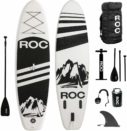Because paddleboarding looks so fun and recreational, not many people would think that it’s just an activity to do to pass the time or to relax. However, there are many benefits to paddleboarding, whether you’re looking to get fit and lose some weight in the process, or an experienced water sports enthusiast looking for a new challenge. SUPs are suitable for high impact workouts and help to engage and build the muscles through various activities.
Here, we take a look at how stand-up paddleboarding can help to tone the body and build muscle.
Low Impact Workout
If you’re not at the peak of fitness or looking for a good way to lose a few pounds and tone up your muscles, this is an excellent way to start. Even paddling through the water to get on your SUP uses muscles, and if you’re not used to using them, you’ll notice it. Unlike some sports, you are far less likely to damage tendons or ligaments, as the power you use and the speed you travel are all under your control. You’re under no pressure to do more than you are capable of as well. You choose what you do and when you do it.
Works the Whole Body
This provides a brilliant advantage of paddleboarding. It gives your whole body a good workout, and most of the time, you don’t even realize it. The simple act of walking into the water with your SUP and balancing on it gives your muscles a workout, and then you have the paddling on top. Here is how the different parts of the body are used when paddling:
- Leg muscles: These are used when you balance, and as the SUP is continually moving, your legs are continuously working to maintain your balance. You may feel stiff when you first start on your SUP, but it won’t take long for your leg muscles to get used to it.
- Arms and shoulder muscles: You use your arms and shoulders for paddling, and many other activities on and around the board. At first, you may feel pain in the shoulders when you paddle as your muscles will not be used to this type of activity. But as you spend more time on the water, you’ll notice your arms and shoulders have more power in them.
- Back: As you balance on your board, although your legs are doing the work, your back will be supporting you too. Similarly, as you move your shoulders to paddle, your back will be moving with them and will slowly strengthen your back as a whole.
- Core and abdomen: You use your core to paddle the SUP, and this includes your stomach. Every stroke you make — if you’re doing it right — will contract your abdominal muscles. Balancing also uses your abdomen so it won’t be long before you feel stronger and look leaner.
Less fatigue
As you build up your muscles, you will feel stronger. If your muscles are working correctly, this means that simple tasks which may leave you feeling fatigued, are now more manageable for you to do. Add to that the advantage of being outdoors with fresh air, and you get an even bigger boost to your fatigue levels. The significant advantage of paddleboarding is that you don’t even notice the increase, as it happens so gradually.





